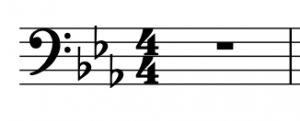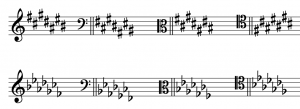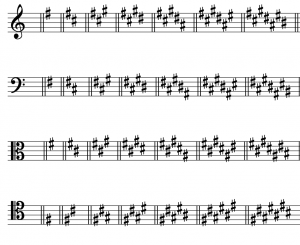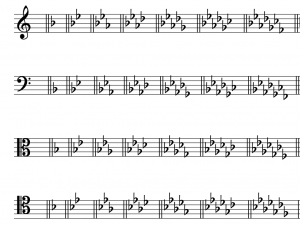Fundamentals
12 Major Scales, Scale Degrees, and Key Signatures
Chelsey Hamm and Bryn Hughes
Key Takeaways
- A major scale is an ordered collection of half- and whole-steps with the ascending succession W-W-H-W-W-W-H.
- Major scales are named for their first note, which is also their last note. Be sure to include any accidentals that apply to this note in its name.
- Scale degrees are solmization syllables notated by Arabic numerals with carets (angled brackets) above them. The scale degrees are [latex]\hat{1}[/latex], [latex]\hat{2}[/latex], [latex]\hat{3}[/latex], [latex]\hat{4}[/latex], [latex]\hat{5}[/latex], [latex]\hat{6}[/latex], and [latex]\hat{7}[/latex].
- Solfège solmization syllables are another method of naming notes in a major scale. The syllables are do, re, mi, fa, sol, la, and ti.
- Each note of a major scale is also named with scale-degree names. The first note of a major scale is called the tonic; the second note, the supertonic, followed by the mediant, subdominant, dominant, submediant, and leading tone.
- A key signature, consisting of either sharps or flats, appears at the beginning of a composition, after a clef but before a time signature.
- The order of sharps in key signatures is F, C, G, D, A, E, and B, while the order of flats is the opposite: B, E, A, D, G, C, F. In sharp key signatures, the last sharp is a half-step below the tonic (the first note of a scale). In flat key signatures, the second-to-last flat is the tonic.
- The circle of fifths is a convenient visual for remembering major key signatures. All of the major key signatures are placed on a circle, in order of number of accidentals.
A scale is an ordered collection of half- and whole-steps (see Half- and Whole-steps and Accidentals to review half- and whole-steps).
Major Scales
A major scale is an ordered collection of half- (abbreviated H) and whole-steps (abbreviated W) in the following ascending succession: W-W-H-W-W-W-H. Listen to Example 1 to hear a major scale, ascending:
Example 1. An ascending major scale.
In Example 1 the whole-steps are labeled with square brackets (and Ws), and the half-steps are labeled with angled brackets (and Hs). A major scale always starts and ends on notes of the same letter name, which should be an octave apart. In Example 1 the first note is C and the last note is C. Major scales are named for their first and last note. Example 1 depicts a C major scale because its first and last note is a C.
Always be sure to include the accidental of the first and last note when you name a scale. Example 2 shows this:
Example 2. A B-flat major scale.
The first and last note in Example 2 is a B♭. Therefore Example 2 is a B♭ (B-flat) major scale. You must say and write the flat, because B is different from the note B♭. Note that the pattern of half- and whole-steps is the same in every major scale, as shown in Examples 1 and 2.
Scale Degrees, Solfège, and Scale-degree Names
Musicians name the notes of major scales in several different ways. Scale degrees are solmization syllables notated by Arabic numerals with carets, angled brackets, above them. The first note of a scale is [latex]\hat{1}[/latex] and the numbers ascend until the last note of a scale, which is also usually [latex]\hat{1}[/latex] (although some instructors prefer [latex]\hat{8}[/latex]). Example 3 shows a D major scale with its scale-degree names and solfège labeled:
Example 3. A D major scale.
Each scale degree is labeled with an Arabic numeral and a caret in Example 3.
Solfège solmization syllables are another method of naming notes in a major scale. The syllables do, re, mi, fa, sol, la, and ti can be applied to the first seven notes of any major scale; these are analogous to the scale degrees [latex]\hat{1}[/latex], [latex]\hat{2}[/latex], [latex]\hat{3}[/latex], [latex]\hat{4}[/latex], [latex]\hat{5}[/latex], [latex]\hat{6}[/latex], and [latex]\hat{7}[/latex]. The last note is do ([latex]\hat{1}[/latex]), because it is a repetition of the first note. Example 3 shows solfège applied to a D major scale, underneath the scale degrees. Because do ([latex]\hat{1}[/latex]) changes depending on what the first note of a major scale is, this method of solfège is called movable do. This is in contrast to a fixed do solmization system, in which do ([latex]\hat{1}[/latex]) is always the pitch class C.
Each note of a major scale is also named with scale-degree names. The first note of a major scale is called the tonic; the second note, the supertonic, followed by the mediant, subdominant, dominant, submediant, leading tone, and tonic:
[table id=37 /]
Example 4. Scale degree, solfège, and scale-degree names.
Example 5 shows these scale-degree names applied to an A♭ major scale:
Example 5. An A♭ major scale with scale-degree names.
Example 5 shows the notes of the A♭ major scale in order. Example 6 shows the notes of the A♭ major scale out of order, with scale-degree names:

In Example 6, the numbers and arrows above the staff indicate generic intervals above and below the tonic. This example shows how the names of the scale degrees derived. The Latin prefix “super” means above, so the supertonic is a second above the tonic. The leading tone is a half-step (a second) below the tonic; it is often thought of as “leading” towards the tonic. The Latin prefix “sub” means below; therefore, the mediant is a third above the tonic, while the submediant is a third below the tonic. Likewise, the dominant is a fifth above the tonic, while the subdominant is a fifth below the tonic. It is a common misconception that the subdominant is so named because it is a second below the dominant, but this is not true, as demonstrated in Example 6.
Key Signatures
A key signature, consisting of either sharps or flats, appears at the beginning of a composition, after a clef but before a time signature. You can remember this order because it is alphabetical: clef, key, time. Example 7 shows a key signature, after a bass clef but before a time signature:

Major key signatures collect the accidentals in a major scale and place them at the beginning of a composition so that it is easier to keep track of which notes have accidentals applied to them. In Example 7, there are flats on the lines and spaces that indicate the notes B, E, and A (reading left to right). Every B, E, and A in a composition with this key signature will now be flat, regardless of octave. Example 8 demonstrates this:

In Example 8, both of these Bs will be flat, because B♭ is in the key signature. All of the Bs, Es, and As after this key signature will be flat, regardless of their octave.
There are flat key signatures and sharp key signatures. The order of the flats and sharps and key signatures is the same, regardless of clef. Example 9 shows the order of sharps and flats in all four clefs that we have learned:

The order of sharps is always F, C, G, D, A, E, B. This can be remembered with the mnemonic: Fat Cats Go Down Alleys (to) Eat Birds. Notice that sharps are always played on the same lines and spaces, making a somewhat zig-zag pattern, alternating going down and up. In the treble, bass, and alto clefs, this pattern “breaks” after D♯, and then resumes. In tenor clef, there is no break, but F♯ and G♯ appear in the lower octave instead of the upper octave.
The order of the flats is the opposite of the order of the sharps: B, E, A, D, G, C, F. This makes the order of flats and sharps palindromes. The order of flats can be remembered with this mnemonic: Birds Eat And Dive Going Crazy Far. The flats always make a perfect zig-zag pattern, alternating going up and down, regardless of clef, as seen in Example 9.
There are easy ways to remember which key signature belongs to which major scale. In sharp key signatures, the last sharp is a half-step below the tonic (the first note of a scale). Example 10 shows three sharp key signatures in different clefs:

The first key signature in Example 10 is in treble clef. The last sharp (in this case the only sharp), F♯, is a half-step below the note G. Therefore, this is the key signature of G major. The second key signature in Example 10 is in bass clef. The last sharp, G♯, is a half-step below the note A. Therefore, this is the key signature of A major. The third key signature in Example 10 is in alto clef. The last sharp, E♯, is a half-step below the note F♯. Therefore, this is the key signature of F♯ major.
In flat key signatures, the second-to-last flat is the tonic (the first note of a scale). Example 11 shows three flat key signatures in different clefs:

The first key signature in Example 11 is in bass clef. The second-to-last flat in this key signature is B♭. Therefore, this is the key signature of B♭ major. The second key signature in Example 11 is in treble clef, and its second-to-last flat is A♭. Therefore, this is the key signature of A♭ major. The third key signature in Example 11 is in tenor clef, and its second-to-last flat is G♭. Therefore, this is the key signature of G♭ major.
There are two key signatures that have no “tricks” that you will simply have to memorize. These are C major, which has nothing in its key signature (no sharps or flats), and F major, which has one flat (B♭). Example 12 shows these key signatures, the first in treble clef and the second in bass clef:

Example 13 shows all of the sharp key signatures in order:

Example 13. The key signatures of C, G, D, A, E, B, F♯, and C♯ in all four clefs.
Example 13 first shows the key signature of C major (with no sharps or flats), and then the key signatures of C, G, D, A, E, B, F♯, and C♯ in all four clefs. Example 14 shows all of the flat key signatures in order:

Example 14 first shows the key signature of C major (with no sharps or flats), and then the key signatures of F, B♭, E♭, A♭, D♭, G♭, and C♭ in all four clefs.
There is one other “trick” which might make memorization of the key signatures easier. C major is the key signature with no sharps or flats, C♭ is the key signature with every note flat (7 flats total), and C♯ is the key signature with every note sharp (7 sharps total). Remembering this may be helpful when memorizing your major key signatures.
Major key signatures are said to be “real” if they are one of the key signatures in Examples 13 or 14. If a double accidental is needed for a key signature (such as a double sharp or double flat), then a major key signature is said to be “imaginary.” Example 15 shows an F♭ major scale:
Example 15. An F♭ major scale in treble clef.
This F♭ major scale and its associated key signature are imaginary because there is a B𝄫. Occasionally, you may perform a composition which is in an imaginary key.
The Circle of Fifths
The circle of fifths is a convenient visual. In the circle of fifths all of the major key signatures are placed on a circle, in order of number of accidentals. The circle of fifths is so named because each of these key signatures are a fifth apart. Example 16 shows the circle of fifths for major key signatures:

If you start at the top of the circle (12 o’clock), the key signature of C major appears, which has no sharps or flats. If you continue clockwise, sharp key signatures appear, each subsequent key signature adding one more sharp. If you continue from C major counter-clockwise, flat key signatures appear, each subsequent key signature adding one more flat. The bottom three key signatures (at 7, 6, and 5 o’clock) in Example 16 are enharmonic . For example, B major and C♭ major scales will sound the same because B and C♭ are enharmonic. However, B and C♭ major scales have different key signatures—the former (B) is a five sharp key, while the latter (C♭) is a seven flat key.
- Major Scales Tutorial (musictheory.net)
- Major Scales (Practical Chords and Harmonies)
- Major Scales (YouTube)
- Scale Degree Names (musictheoryfundamentals.com)
- Scale Degree Names (musictheory.net)
- Solfège History and Tutorial (Earlham College)
- Scale Degrees, Solfège, and Scale-degree Names (YouTube)
- Major Key Signatures (musictheory.net)
- Sharp Key Signatures (YouTube)
- Flat Key Signatures (YouTube)
- Major Key Signature Flashcards (music-theory-practice.com)
- The Circle of Fifths (YouTube)
- The Circle of Fifths (Classic FM)
- Writing Major Scales (.pdf, .pdf), from Tonic and Other Scale Degrees (.pdf)
- Identifying Major Scales (.pdf)
- Adding Accidentals to Write Major Scales (.pdf)
- Writing Major Key Signatures (.pdf)
- Writing and Identifying Major Key Signatures, p. 2 (.pdf)
- Identifying Major Key Signatures (.pdf)
- Major Keys Worksheets for Children (.pdf)
- Scale Degrees or Solfège (.pdf, .pdf, .pdf)
An ordered collection of half- and whole-steps
The relative number of a note in a scale relative to the first note of that scale
A system that pairs each note of a scale with a particular syllable
The numbers 0, 1, 2, 3, 4, 5, 6, 7, 8, and 9
Angled bracket placed above Arabic numerals to indicate scale degrees
The application of solemnization syllables (Do, Re, Mi, Fa, Sol, etc.) to notes within the context of scales
A movable system of names for scale degrees
Accidentals placed at the beginning of a work which apply throughout the work (and which imply a particular tonic)
Raises a note by a half-step
Lowers a note by a half-step
Shows the relationship between major (and/or minor) key signatures, by placing the key signatures around a circle in order of number of accidentals
An ordered collection of half-steps (H) and whole-steps) as follows (ascending): W-W-H-W-W-W-H
A series of eight notes (such as C to C)
Do is the first scale degree in a scale; this is in contrast to Fixed Do, when Do is always the pitch class C
Do is always the pitch class C, Re the pitch class D, etc. regardless of scale
The number of scale steps between notes of a collection or scale
Raises a note by two half-steps
Lowers a note by two half-steps
Having a different letter name but sounding the same (e.g. f-sharp and g-flat)

